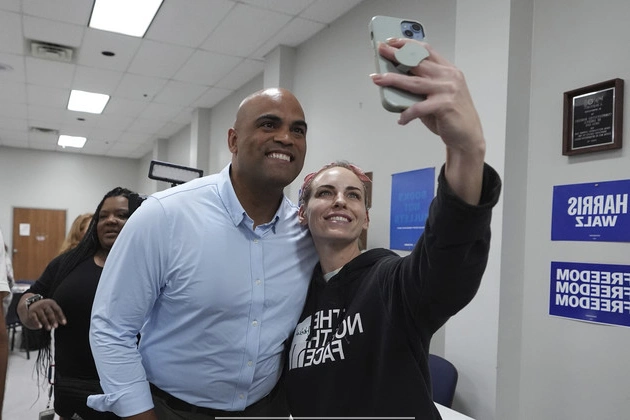
ALBANY, New York — Flogged by voters — and President Donald Trump — about rising utility bills, Democratic lawmakers in blue states are zeroing in on a juicy target: utility profits.
Squeezed by high energy prices on one end and attacks from Republicans on the other, they’re introducing proposals from New York to California to limit how much investors can earn from gas and electric utilities. The idea is to defend against attacks like Trump’s executive order last week blaming blue states’ clean energy policies for high energy costs — and, potentially, to lower bills.
Addressing Energy Affordability Challenges
“When you knock on thousands of doors, you start to hear a theme, and the theme was, ‘I don’t know how I’m going to pay my utility bills,’” said Rhode Island state Rep. Megan Cotter, a Democrat who represents a district Trump won in November.
Democrats were already wrestling with high energy prices before Trump regained office. While electricity bills rose 3 percent nationwide from January 2024 to 2025, they rose more than 11 percent in New York, New Jersey and Connecticut, according to the U.S. Energy Information Administration.
The rising costs have put Democratic lawmakers and governors on the defensive — and lashing out at utilities and power grid managers — as they face attacks from Republicans and critics of their clean energy goals, the costs of which are starting to show up on bills.
The Case for Renewable Energy Transition
Supporters of moving to renewable energy and electrification argue it will ultimately insulate U.S. residents from volatile swings in fossil fuel prices — and provide cleaner air and reduce planet-warming emissions. But since Democrats have vowed sweeping changes to the energy system, they have to ensure voters don’t view that transition off fossil fuels as too costly in the short term.
“If the Democrats, who are in the majority, don’t do anything about these electric bills, it may end up falling in their lap,” said Connecticut House Minority Leader Vincent Candelora, a Republican.
Challenges and Pushback from Utilities
Utility executives are pushing back on the efforts to limit their profits, arguing the moves could dampen investment in the power grid and ultimately drive rates up further.
“It hurts our credit worthiness,” said Southern California Edison President and CEO Steve Powell. “Our costs go up. And then ultimately, customers end up paying for that.”
Cotter introduced a bill in January to cap utilities’ “return on equity” — a key financial metric for utility companies that determines how much shareholders can earn on their investments — at 4 percent, far below the industry’s 2024 average of 9.7 percent.
Proposals in New York, California and New Jersey would similarly limit utility profits. New York Sen. James Skoufis’ February proposal would impose a 4 percent cap, like Cotter’s, while New Jersey Assemblymember Eliana Pintor Marin introduced one last month emphasizing that utilities should receive the “lowest reasonable return.”
Potential Impacts and Political Landscape
In California, where electricity rates are close to double the national average, Assemblymember Cottie Petrie-Norris is asking the Public Utilities Commission to deny utilities’ requests to increase their returns on equity by about 1 percent, which would raise shareholder profits in turn to more than 11 percent.
“Asking to increase it is just totally unacceptable, and honestly, a failure to read the room,” Petrie-Norris said.
And it’s not just Democrats. Republican Sen. Don Gaetz in Florida, the father of former House Rep. Matt Gaetz, also introduced a bill to limit return on equity to a “risk-free rate of return,” equal to investments considered extremely low risk, like U.S. Treasury bonds.
“Increasingly I have constituents saying to me, ‘Why are we paying the rates we are paying?’” Gaetz said in an interview upon introducing the bill in January, as Florida Power & Light Co. prepared to seek a rate hike of 2.5 percent per year over the next four years.
Government Response and Industry Reactions
Democratic governors are also chiming in. Connecticut Gov. Ned Lamont has said he was “mad as hell” about high summer utility bills. California Gov. Gavin Newsom ordered regulators last fall to cut underperforming energy efficiency programs and maximize the credit customers receive on their bills from the state’s cap-and-trade proceeds. In Massachusetts, Gov. Maura Healey last month ordered gas utilities to reduce costs immediately, announced plans to refund millions collected for clean energy programs and promised legislation to limit future rate increases.
New York Gov. Kathy Hochul earlier this year slammed Con Edison, the state’s largest utility for proposing double-digit increases for gas and electricity. She told the company to go back to the drawing board and revise its request, which Con Ed declined to do.
Con Ed wants to increase its return on equity from the current 9.25 percent to 10.1 percent.
“Shocking,” Hochul said of Con Ed’s proposed rate hike. “This is intolerable to me.”
Con Ed officials say major investments are needed to support more electric vehicles and heat pumps driven by city and state policies.
“We work with our regulator and other stakeholders to arrive at a rate of return that balances our need to attract investors with our need to keep rates affordable, especially for low- and moderate-income customers,” said Jamie McShane, a spokesperson for Con Ed.
Expert Insights and Future Directions
State-appointed ratepayer advocates, who work with regulators to try to manage costs, have long advocated for lower returns. But the flurry of interest from elected officials is new.
“It’s always an issue in our little world,” said Brian Lipman, the head of New Jersey’s Division of Rate Counsel. “It’s the first time I’ve seen it come outside the utility world and other people paying attention to it.”
It’s not clear whether the proposals will actually work to lower bills. All else being equal, lower return on equity would lower utilities’ costs — and customers’ bills. But cutting utilities’ returns also risks lowering their bond ratings and increasing their debt costs, as utilities, analysts and some state regulators themselves argue.
Utility representatives say the caps proposed in Rhode Island and New York would provide little reason to invest in maintaining the essential systems to deliver gas and electricity — and would raise costs for customers in the long term.
The Case for Balanced Returns
“Lower credit ratings will impact the cost (i.e., interest rates) and availability of debt capital, and over the long term is likely to require much higher overall rates of return, which would need to be recovered from customers through higher utility rates,” said Brian Welsch, vice president of rates and regulatory affairs at New York gas utility National Fuel.
Other experts think that while the 4 percent level proposed in Rhode Island would be too low, the bill is moving in the right direction.
“It draws attention to the problem that current authorized ROEs are way too high,” said Mark Ellis, former chief economist and chief of corporate strategy at Sempra Energy, the parent company of Southern California Gas Co. and San Diego Gas & Electric, who now advocates for lower returns on equity for utilities nationwide as a way to bring down bills.
Ellis argues in a report for the American Economic Liberties Project that utilities have been overcharging the public, requesting double digits when they should realistically be earning under 6.7 percent, below the long-term forecast returns for the stock market, since he says utility investments are lower risk.
With the current market volatility and plummeting stocks, there could be even more pressure to lower utility returns. New Jersey’s ratepayer advocate said he plans to push for lower returns in a pending rate case given the “current environment.”











